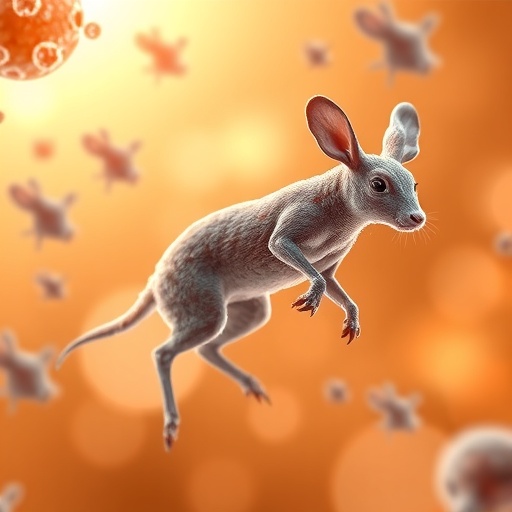In recent years, the challenge of effectively delivering chemotherapy drugs to cancer cells while minimizing damage to healthy tissues has posed an ongoing dilemma for researchers in the field of oncology. A groundbreaking study conducted by a team of scientists at Northwestern University has set the stage for a paradigm shift in cancer treatment. The researchers have re-engineered a common chemotherapy drug, 5-fluorouracil (5-Fu), transforming it into a more soluble and targeted therapeutic agent that dramatically enhances efficacy and reduces toxicity levels. This innovative approach, based on the structural design of spherical nucleic acids (SNAs), represents a promising advance in the ongoing battle against cancer, particularly acute myeloid leukemia (AML).
5-Fu has long been a staple in cancer treatments; however, its solubility issues have hindered its effectiveness and generated a range of side effects. This study marks a significant achievement in nanomedicine, a field that focuses on utilizing nanoscale materials to enhance drug delivery systems. By embedding 5-Fu into SNAs, the research team has created an effective delivery vehicle that significantly increases the drug’s ability to penetrate cancer cells. By chemically bonding the drug into the DNA scaffold of the SNA, researchers have successfully engineered a molecule that is not only soluble in biological fluids but also adept at being recognized and absorbed by target cells.
Why is this transformation particularly important? In traditional chemotherapy, the effectiveness of treatment often diminishes due to the lack of precision in targeting cancerous cells. Healthy tissues frequently suffer collateral damage as a result, leading to debilitating side effects such as fatigue, nausea, and even severe complications like heart failure. By contrast, the SNA-based drug selectively targets myeloid cells, which overexpress scavenger receptors that readily absorb these engineered compounds. This targeted approach paves the way for safer and more effective treatments, capable of sparing healthy cells from the destructive impacts of chemotherapy.
During their experiments on small animal models of AML, the Northwestern research team observed that the SNA formulation of 5-Fu entered the leukemia cells with 12.5 times more efficiency compared to the traditional delivery methods. This striking finding underscores the immense potential of SNAs in the future of cancer therapies. The weaponized nanostructures demonstrated an astonishing ability to induce apoptosis (programmed cell death) in leukemia cells, showcasing efficacy improvements of up to 20,000 times over standard chemotherapy approaches.
Additionally, the study revealed a remarkable capacity for the SNA formulation to decelerate cancer progression in the animal models, achieving a reduction of nearly 59-fold. This extraordinary level of efficiency signifies a substantial step toward developing specialized cancer treatments that can work at lower doses, ultimately reducing the toxic burden on patients. The findings suggest a groundbreaking pathway to transforming existing chemotherapy regimens for various forms of cancer, expanding the treatment horizons for patients in need.
It is critical to note that the research does not merely represent a novel application of known principles; it embodies a true advancement in structural nanomedicine. This new frontier allows scientists to finely tune not just the composition but also the structural characteristics of drugs, thereby paving the way for innovative therapeutic strategies. With seven SNA-based therapies currently undergoing clinical trials, it is evident that this line of research is set to revolutionize the landscape of cancer treatment.
Chad A. Mirkin, a renowned chemist and one of the principal investigators behind this revolutionary study, has consistently emphasized the fundamental issues related to drug solubility in the context of chemotherapy. The traditional challenges associated with 5-Fu—its low solubility and the resultant toxicity—have prompted a renewed focus on developing better solubility profiles for existing chemotherapeutics. The ability to package chemotherapy drugs in SNAs effectively circumvents previous hurdles by enhancing bioavailability and ensuring targeted delivery.
In the realm of cancer treatment, the implications of this research extend beyond a single drug; the breakthroughs herald a broad application of structural nanomedicine in fighting not only cancers but also other diseases such as infectious and neurodegenerative disorders. By utilizing precise structural controls, researchers can engineer targeted treatment strategies that significantly improve therapeutic outcomes across various pathologies.
The road ahead for these innovative therapies is promising yet cautious. Following the success of their animal model studies, Mirkin and his team plan to expand their research cohort to gauge efficacy across larger populations, subsequent steps involving transition to larger animal models and eventually, human clinical trials. Each iteration represents an important step toward realizing the potential of SNAs in norming the future of cancer treatments, drawing closer to a moment where chemotherapy can be personalized and significantly more tolerable.
In conclusion, the achievements of the Northwestern team represent a pivotal moment in oncology, where interdisciplinary approaches truly converge to offer hope to cancer patients. By shifting the paradigm on how we deliver drugs through advanced materials such as SNAs, researchers are unlocking new possibilities for treatment frameworks that promise not just increased effectiveness but improved quality of life during the fight against cancer.
Subject of Research:
Chemotherapy delivery systems targeting acute myeloid leukemia.
Article Title:
Chemotherapeutic spherical nucleic acids.
News Publication Date:
29-Oct-2025.
Web References:
(References not provided in the content)
References:
(References not provided in the content)
Image Credits:
Credit: Mirkin Research Group/Northwestern University.
Keywords
Chemotherapy, Spherical Nucleic Acids, Drug Delivery, Acute Myeloid Leukemia, Nanomedicine, Targeted Delivery, Cancer Research.
Tags: 5-fluorouracil re-engineeringacute myeloid leukemia treatmentcancer treatment innovationsdrug solubility improvementseffective cancer cell penetrationleukemia eradication studiesnanomedicine advancementsnanotechnology in medicineoncology research breakthroughsreducing chemotherapy toxicityspherical nucleic acids technologytargeted chemotherapy delivery






